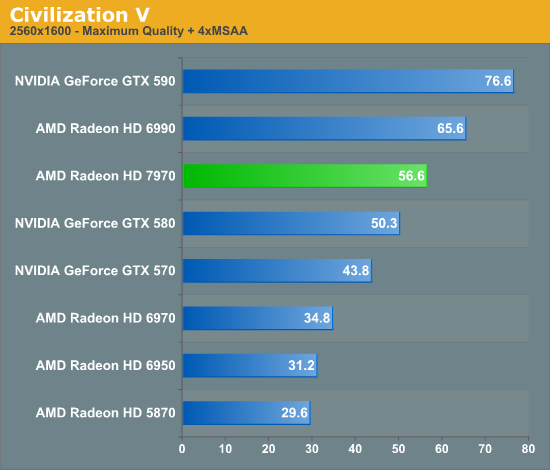AMD Radeon HD 7970 Review: 28nm And Graphics Core Next, Together As One
by Ryan Smith on December 22, 2011 12:00 AM EST- Posted in
- GPUs
- AMD
- Radeon
- ATI
- Radeon HD 7000
Civilization V
Our final game, Civilization 5, gives us an interesting look at things that other RTSes cannot match, with a much weaker focus on shading in the game world, and a much greater focus on creating the geometry needed to bring such a world to life. In doing so it uses a slew of DirectX 11 technologies, including tessellation for said geometry, driver command lists for reducing CPU overhead, and compute shaders for on-the-fly texture decompression.


Because of the fact that Civilization V uses driver command lists, we were originally not going to include it in this benchmark suite as a gaming benchmark. If it were solely a DCL test it would do a good job highlighting the fact that AMD doesn’t currently support the feature, but a poor job of actually explaining any hardware/architectural differences. It was only after we saw AMD’s reviewer’s guide that we decided to go ahead and include it, because quite frankly we didn’t believe the numbers AMD had published.
With the GTX 580 and the 6970, the 6970 routinely lost to the GTX 580 by large margins. We had long assumed this was solely due to NVIDIA’s inclusion of DCLs, as we’ve seen a moderate single-GPU performance deficit and equally moderate multi-GPU lead for AMD melt away when NVIDIA added DCL support. The 7970 required that we rethink this.
If Civilization V was solely a DCL test, then our 2560 results would be impossible – the 7970 is winning by 12% in a game NVIDIA previous won by a massive margin. NVIDIA only regains their lead at 1680, which at this resolution we’re not nearly as likely to be GPU-bound.
So what changed? AMD has yet to spill the beans, but short of a secret DCL implementation for just CivV we have to look elsewhere. Next to DCL CivV’s other killer feature is its use of compute shaders, and GCN is a compute architecture. To that extent we believe at this point that while AMD is still facing some kind of DCL bottleneck, they have completely opened the floodgates on whatever compute shader bottleneck was standing in their way before. This is particularly evident when comparing the 7970 to the 6970, where the 7970 enjoys a consistent 62% performance advantage. It’s simply an incredible turnabout to see the 7970 do so well when the 6970 did so poorly.
Of course if this performance boost really was all about compute shaders, it raises a particularly exciting question: just how much higher could AMD go if they had DCLs? Hopefully one day that’s an answer we get to find out.










292 Comments
View All Comments
RussianSensation - Thursday, December 22, 2011 - link
I think his comment still stands. In terms of a performance leap, at 925mhz speeds at least, this is the worst improvement from 1 major generation to the next since X1950XTX -->2900XT. Going from 5870 to 6970 is not a full generation, but a refresh. So for someone with an HD5870 who wants 2x the speed increase, this card isn't it yet.jalexoid - Thursday, December 22, 2011 - link
How's OpenCL on Linux/*BSD? Because I fail to see real high performance use in Windows environments for any GPGPU.For GPGPU the biggest target should be still Linux/*BSD because they are the dominating platforms there....
R3MF - Thursday, December 22, 2011 - link
"Among the features added to Graphics Core Next that were explicitly for gaming, the final feature was Partially Resident Textures, which many of you are probably more familiar with in concept as Carmack’s MegaTexture technology."Is this feature exclusive to gaming, or is it an extension of a visualised GPU memory feature?
i.e. if running Blender on the GPU via the cycles renderer will i be able to load scenes larger than local graphics memory?
Ryan Smith - Thursday, December 22, 2011 - link
It's exclusive to graphics. Virtualized GPU memory is a completely different mechanism (even if some of the cache concepts are the same).With that said I see no reason it couldn't benefit Blender, but the benefits would be situational. Blender would only benefit in situations where it can't hold the full scene, but can somehow hold the visibly parts of the scene by using tiles.
R3MF - Friday, December 23, 2011 - link
cheers RyanFinally - Thursday, December 22, 2011 - link
...the 2nd generation HD8870 feat. GCN, 3W idle consumption and hopefully less load consumption than my current HD6870. Just let a company like Sapphire add a silent cooler and I'm happy.poohbear - Thursday, December 22, 2011 - link
Btw why didnt Anandtech overclock this card? it overclocks like a beast according to all the other review sites!Esbornia - Thursday, December 22, 2011 - link
Cause they want you to think this card sucks come on guys everybody in the internet knows this site sucks for reviews that are not from Intel products.SlyNine - Thursday, December 22, 2011 - link
lol troll. This site has prefered who ever had the advantage in what ever area. They will do a follow up of its OCing and when they first show a card they show it at stock only.I do not OC my videocards, whats the point in adding 5% more gain in games that are running maxed anyways.
RussianSensation - Thursday, December 22, 2011 - link
Is this comment supposed to be taken seriously? Go troll somewhere else.